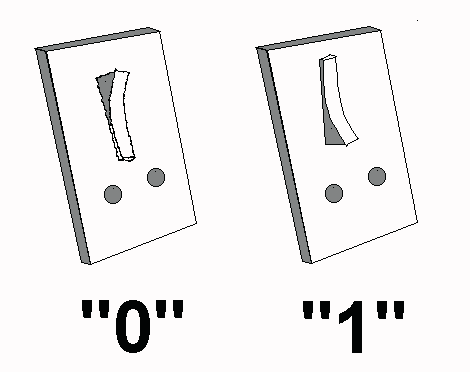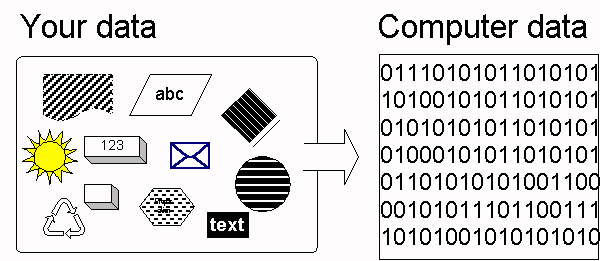|
|
|
Our
PCs are data processors. The PC's function is simple: to process
data, and the processing is done electronically inside the
CPU and between the other components. That sounds simple,
but what is data, and how is it processed electronically
in a PC? That is the subject of this page
|
Analogue
Data
The
signals, which we send each other to communicate, is data. Our
daily data have many forms: sound, letters, numbers, and other
characters (handwritten or printed), photos, graphics, film.
All this data is in its nature analog, which means that
it varies in type. In this form, the data-signals are unusable
in a PC. The PC can only process concise, simple data formats.
Such data can be processed very effectively. |
Digital Data
The
PC is an electric unit. Therefore, it can only deal with data,
which are associated with electricity. That is accomplished
using electric switches, which are either off or on. You can
compare with regular household switches. If the switch is off,
the PC reads numeral 0. If it is on, it is read as numeral one.
See the illustration below: |
|

|
With
our electric switches, we can write 0 or 1. We can now start
our data processing!
The
PC is filled with these switches (in the form of transistors).
There are literally millions of those in the electronic components.
Each represents either a 0 or a 1, so we can process data
with millions of 0s and 1s.
|
|
Bits
Each
0 or 1 is called a bit. Bit is an abbreviation of the
expression BInary digiT. It is called binary, since it is
derived from the binary number system:
|
|
0
|
1 bit
|
|
1
|
1 bit
|
|
0110
|
4 bit
|
|
01101011
|
8 bit
|
|
|
Numbers,
as known in the decimal-system
|
Same numbers
in binary system
|
|
0
|
0
|
|
1
|
1
|
|
2
|
10
|
|
3
|
11
|
|
4
|
100
|
|
5
|
101
|
|
6
|
110
|
|
7
|
111
|
|
8
|
1000
|
|
Binary
The
binary number system is made up of digits, just like our common
decimal system (10 digit system). But, while the decimal system
uses digits 0 through 9, the binary system only uses digits
0 and 1.
If
you are interested in understanding the binary number system,
then here is a brief course. See if you can follow the system.
See how numbers are constructed in the binary system, using
only 0s and 1s:
|
|
Digital
We have seen that the PC appears
capable of handling data, if it can receive them as 0s and
1s. This data format is called digital. If we can translate
our daily data from their analog format to digital format,
they will appear as chains of 0s and 1s, then the PC can handle
them.
So, we must be able to digitize
our data. Pour text, sounds, and pictures into a funnel, from
where they emerge as 0s and 1s:
|
 |
| |
| |
|
| |
|
|